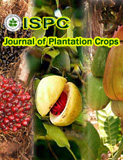Survey and identification of pathogens causing leaf spot disease of arecanut in selected areas of hill zone of Karnataka
DOI:
https://doi.org/10.25081/jpc.2023.v51.i3.8860Abstract
Arecanut (Areca catechu) is an important plantation crop of India belongs to the family Arecaceae. The arecanut production in Malnad and coastal regions is adversely affected by various biotic and abiotic stresses which causes a drastic reduction in yield. Now a days, among the biotic stresses, leaf spot caused by Colletotrichum gloeosporioides, Phyllosticta arecae and Pestalotia arecae are becoming more severe. In order to asses the severity of leaf spot diseases an intensive roving survey was carried out during Kharif, 2022 in arecanut growing three taluks of Shivamogga and three taluks of Chikkamagaluru district in Karnataka. Among the six taluks surveyed highest disease severity (81.50 %) caused by Colletotrichum gloeosporioides was recorded in Adagalale village of Sagara taluk and least disease severity (18.50 %) was recorded in Maloor village of Thirthahalli taluk. Highest disease severity (42.20 %) Phyllosticta arecae was recorded in Surakodu village of Sringeri taluk and no disease was recorded in Hilikunji and Nidagodu villages of Hosanagara taluk. Among the six taluks surveyed for leaf spot caused by Pestalotia arecae, highest disease severity (62.50 %) was recorded in Karekumbri village of Thirthahalli. The leaf spot causing pathogens were identified based on symptoms and conidial morphological features as Colletotrichum gloeosporioides, Phyllosticta arecae and Pestalotia arecae.
Downloads
References
Anonymous. 2020. Directorate of Arecanut and Spice Development, Calicut, Kerala. https://www.dasd.gov.in/adminimage/Arecanut_ area_and_production.pdf.
Ahmed, M.D., Hossain, Kazi, Bashar, M. 2014. Anthracnose of betel vine and it’s in vitro management. Dhaka University Journal of Biological Science 23 (2):127-133
Arpitha.. 2022. Investigations on Phyllosticta leaf spot of ginger (Zingiber officinale Rose.). MSc (Agri.) Thesis, Keladi Shivappa Nayaka University of Agricultural and Horticultural Sciences, Shivamogga.
Arunprasad. 2022. Variability studies on Colletotrichum gloeosporioides causing inflorescence die back and leaf blight disease in arecanut. M. Sc. (Agri.) Thesis, Keladi Shivappa Nayaka University of Agricultural and Horticultural Sciences, Shivamogga.
Balasimha, D. and Rajagopal, V. 2004. Introduction. In: Arecanut. (Eds: Balasimha D, Rajagopal V). Central Plantation Crops Research Institute, Kasaragod, Kerala, India. p. 1-6.
Bavappa, K. V. A. 1982. The Arecanut palm. Central Plantation Crops Research Institute, Kasaragod. p.340
Bhat, S.K., Bhat, S. and Kalladka, P.K. 2021. Effects of Arecanut (Areca catechu L.). Chewing on human health: Misleading titles lead to wrong notions. International Journal of Scientific Research Methodology 17 (3): 95-109.
Bhat, R. G. 1983. Studies on leaf blight of arecanut (Areca catechu L.) caused by Phyllositica arecae Hohnel M. Sc. (Agri.) thesis, University of Agricultural Sciences, Bangalore.
Cannon, P. F., Damm, U., Johnston, P.R. and Weir, B.S. 2012. Colletotrichum - current status and future directions. Studies in Mycology 73:181-–213.
Carl, D.L. and Bartlett, R. 1922. A demonstration of numerous distinct strains within normal species Pestalotia guepinii Desm. American Journal of Botany 9: 79-92.
Chowdhury, S. 1946. A leaf spot of Borassus flabellifer L. caused by Pestalotia palmarum Cke. Journal of Indian Botanical Society 25: 131-137.
Fernadez, R.L., Rivera, M.C., Varsallona, B. and Wright, E.R. 2015. Disease prevalence and symptoms caused by Alternaria tenuissima and Pestalotiopsis guepinii on blueberry in Entre Rios and Buenos Aires, Argentina. American Journal of Plant Science 6: 3082-3090.
Hegde, G.M. 2018. Field efficacy of fungicides to manage leaf spot of arecanut. Advances in Plants and Agricultural Research 8 (6): 496-498.
Hegde, Y. and Hegde, R.K. 1986. Studies on anthracnose of arecanut ( Areca catechu L . ) caused by Colletotrichum gloeosporioides (Penz.) Penz and Sacc. Plant Pathology Newsletter 4:24.
Hegde, Y., Hegde, R.K. and Kulkami, S. 1988. An unrecorded pathogen on arecanut. Plant Pathology Newsletter 6: 42-44.
Höhnel, F. (1912) FragmentezurMykologie XIV. Mitteilung (No. 719 bis 792). Sitzungsber Akad Wiss Wien, Mathem Naturwiss Kl, Abt. I. 121:339–424.
Kamle, M. and Kumar, P. 2016. “Colletotrichum gloeosporioides: pathogen of anthracnose disease in mango (Mangifera indica L.),” in Current Trends in Plant Disease Diagnostics and Management Practices. eds. Kumar P., Gupta V. K., Tiwari A. K., Kamle M. (Cham, SZ: Springer International Publishing), 207–219.
Kyada, J . Z . 2006 . Investigation on grey blight (Pestalotiopsis guepinii (desm.) stey.) of mango (Mangifera indica L.). M.Sc. (Agri.) Thesis. Junagadh Agricultural University, Junagadh.
Naik, G.B., Hariprasad, K. and Maheshwarappa, H.P. 2021. Survey for the occurrence of arecanut diseases in Shivamogga district of Karnataka. The Pharma Innovation Journal 10(8): 529-530.
Patel, R.B. 1988. Studies on grey leaf spot of mango, Pestalotiopsis mangiferae (Henn.) Steyaert and its control. M.Sc. (Agri.) Thesis, Gujarat Agricultural University, Navsari, Gujarat (Inida).
Pruthviraj. 2018. Studies on fungal fruit spot and fruit rot of pomegranate. M. Sc (Agri.) Thesis, University of Agricultural and Horticultural Sciences, Shivamogga.
Ramkrishna, D., Fredrickson, A. G. and Tsuchiya, H. M., 1942, Dynamics of microbial propagation: Models considering inhibitors and variable cell composition. Biotechnol. & Bioeng., 9(1): 129-170.
Rao, V.G. 1964. The genus Pestalotia palmarum in Bombay Maharashtra IV. Mycopathologia et mycologia applicata 28:19-22.
Sastry, M. N. L. and R. K. Hegde., 1987, Pathogenic variation in Phytophthora species affecting plantation crops, Indian Phytopathol., 40 (3): 365-369
SelmaouI, K., Touati, J., Chliyeh, M., Touhamil, A. O., Benkirane, R. and Douira, A. 2014. Study of Pestalotiopsis palmarum pathogenicity on Washingtonia robusta (Mexican palm) . International Journal of Pure and Applied Bioscience 2(6): 138-145.
Shabi, E. and Katan T. A. 1983. Occurrence and control of anthracnose of almond in Israel. Plant Disease 67: 1364–1366.
Sharma, M and Kulshrestha, S. 2015. Colletotrichum gloeosporioides: an anthracnose causing pathogen of fruits and vegetables. Bioscience Biotechnology Research Asia 12: 1233–1246.
Shukla, B.N. and Haware, M.P. 1972. Phyllosticta leaf spot of ginger (Zingiber officinale) in Madhya Pradesh. Indian Journal of Mycology and Plant Pathology 2: 93.
Wheeler, B. E. J. 1969. An Introduction to Plant Diseases, John Wiley and Sons Ltd. London. p 301.
Zimowska, B., 2013, Occurrence and characterization of Phyllosticta plantaginis, J. Plant Physiol Patho., 1 (1): 1-6.
Published
How to Cite
Issue
Section
Copyright (c) 2024 Journal of Plantation Crops

This work is licensed under a Creative Commons Attribution 4.0 International License.







 .
.